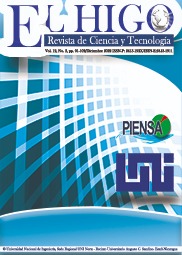Evaluation of human, natural and material factors that affect the use and efficiency of Kanchan filters in the San Juan community, Tipitapa Nicaragua
DOI:
https://doi.org/10.5377/elhigo.v12i2.15193Keywords:
arsenic, adsorption, sand, iron hydroxide, granulometryAbstract
In Nicaragua, the quality of water is affected by the presence of arsenic in concentrations higher than that indicated in CAPRE standards. In the present study, a diagnosis was made of the Kanchan filters built in the San Juan de Tipitapa community and factors that can affect their use and efficiency were determined. Kanchan filters are a low-cost alternative to reduce the presence of this analyte in drinking water. The lack of knowledge on water quality issues, health effects due to arsenic intake and lack of training in operation and maintenance are human factors that affect the use of the filter. When comparing these units with the specifications recommended in the MIT and ENPHO guides, they do not comply with the materials in terms of diameter of fine sand, free space between the bottom of the pan, number of nails and pieces of brick inside the diffuser pan, managing to remove only between 60-70% arsenic. Subsequently, with the same materials from the evaluated units, a filter was assembled at the laboratory level that complies with the provisions, resulting in arsenic <0.01 mg/L, phosphates of 0.2 mg/L, Ph of 8.37 and calcium of 12.38 mg/L. To obtain a good performance in Kanchan filters, it is recommended to comply with fine sand granulometry that retains the arsenic-iron complex and to guarantee the amount of iron hydroxide for arsenic adsorption, as well as to continuously train users in the use and maintenance of the technology.
Downloads
References
Aguilar E., Parra M., Cantillo L., Gómez A. (2000). Intoxicación crónica por arsénico. El Zapote Nicaragua 1996. Med Cut ILA, 28:168-173.
Altamirano M., Bundschuh J. (2009). Natural arsenic groundwater contamination of the sedimentary aquifers of southwestern Sébaco valley, Nicaragua.
Holm, T.(2002). Effects of CO3-2/bicarbonate, Si and PO4-3 on arsenic sorption to HFO. J. AWWA, 94, págs. 174-181.
González M,. Provedor E., Reyes M., López A. y Lara K. (1998). Exposición del Arsénico en comunidades rurales de San Isidro, Matagalpa, 1997.Centro de Estudios de Investigaciones y Estudios de la Salud.
Instituto Nicaragüense de Acueductos y Alcantarillados. (1996). Informe de los resultados de As en comunidades rurales del municipio de San Isidro. Managua, Nicaragua.
Naciones Unidas, (2018). Objetivos de desarrollo sostenible; 17 objetivos para transformar nuestro mundo. Objetivo 6: Garantizar la disponibilidad de agua y su gestión sostenible y el saneamiento para todos. Nueva York.Disponible en: http://www.un.org/sustainabledevelopment/es/water-and-sanitation/.
Ngai, T. and Walewijk, S. 2007. The Arsenic Biosand Filter (ABF) project: design of an appropriate household drinking water filter for rural Nepal, Civil and Environmental Engineering, Massachusetts Institute of Technology. http://web.mit.edu/watsan.
Programa de Investigación y Docencia de Medio Ambiente, Universidad de Ingeniería y UNICEF. (2002). Evaluación rápida de la contaminación por arsénico y metales pesados de las aguas subterráneas de Nicaragua.
Organización Mundial de la Salud. (2011). Guías para la calidad del agua de consumo humano. Recuperado de: https://apps.who.int/iris/bitstream/handle/10665/272403/9789243549958-spa.pdf?ua=1
Organización Mundial de la Salud. (2016). Arsénico. Recuperado de :
http://www.who.int/mediacentre/factsheets/fs372/es/
Organización panamericana de la Salud. (2005). Evaluación rápida de la calidad del agua de bebida en Nicaragua. Recuperado de: http://www.bvsde.org.ni
Downloads
Published
How to Cite
Issue
Section
License
Copyright (c) 2022 Universidad Nacional de Ingeniería

This work is licensed under a Creative Commons Attribution-NonCommercial-NoDerivatives 4.0 International License.
Los artículos publicados en la revista El Higo, Nicaragua, se comparten bajo términos de la licencia Creative Commons: Reconocimiento, No Comercial, Compartir Igual. que permite a terceros utilizar lo publicado siempre que mencionen la autoría del trabajo y a la primera publicación en esta revista. ![]()
Los autores/as pueden realizar otros acuerdos contractuales independientes y adicionales para la distribución no exclusiva de la versión del artículo publicado en esta revista (p. ej., incluirlo en un repositorio institucional o publicarlo en un libro) siempre que indiquen claramente que el trabajo se publicó por primera vez en esta revista.







